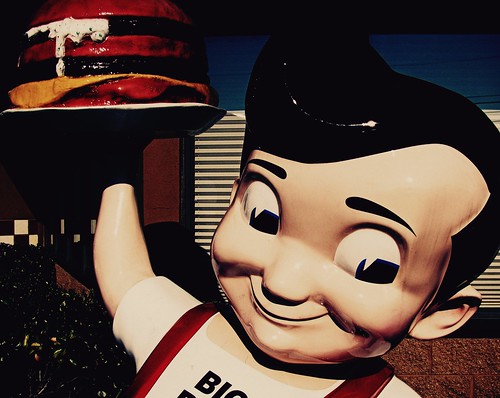Okay, so, the Unconsumption blog is awesome. I’ve gotten a number of very nice comments about it — thanks.
Although what’s even better than nice comments to me would be spreading the word. Blog/tweet/or actually talk about it, tell your friends and your fans your followers, and like that. Thanks to those who have done so.
The contributing team is: Tom Hosford, college student & Murketing Organization intern, Long Island, NY; Andrew Whitelaw, branding/design strategist, Chicago, IL; Steve Chaney, industrial designer, Portland, OR; Kate Bingaman-Burt, artist and educator, Portland, OR; Amy Shaw, writer and curator, Brooklyn, NY; Rob Walker, journalist, Savannah, GA.
You should check it out.
Now, what’s next? Glad you asked!
I’ll tell you tomorrow.
Todd Wasserman, writing about his Twitter adventures, mentions this:
The dirty little secret of Twitter, though, is that many people get high-follower counts by making it known that they will automatically follow you if you follow them. So when I had trouble getting over the 400 barrier, I Googled “twitterers who automatically follow you” and found a list of 237 people who do just that.
Many of these people, it should be noted, have well in excess of 10,000 followers already, which means that not only will they not be receptive to my messages but, because they are following so many people, they will be unlikely to see my messages.
Fascinating.
And makes me wonder: What is more important — the theoretical audience, or the degree of engagement of members of that audience.
Having 10,000 followers is a powerful “signal” that whatever one is saying is important, even if the reality is that none of those 10,000 are listening.
Having 10 followers who are engaged and useful and paying attention might have more utility. But because your audience “looks” small, the signal to others is that nobody cares what you have to say, so it must not be interesting.
Probably some version of this same basic dynamic holds true for blogs, and articles, and even books, but the visibility of audience-count in the Twitter setup just makes it more obvious.
Anyway, I suppose choosing https://www.capefearcardiology.com/clomid-over-the-counter/ between an emphasis audience size and audience quality (yes, I realize it’s not always a choice), is a matter of individual priorities.
Caption: “Big Boy’s not-so-secret sauce.” B l a c k M a g i c version .
 PANEL DISCUSSION
PANEL DISCUSSION
Buying into solar power — and to the potential appeal of collective buying.
This week in Consumed, a business that rounds of packs of consumers to make group buys of solar power.
Collective buying power has been harnessed in various ways in the past, but generally speaking the strategy has been marginal among contemporary American consumers, maybe because it doesn’t mesh well with the rugged individualist’s self-image.
Then again, in a cultural moment when many individuals aren’t feeling all that rugged, perhaps it makes sense that a company called 1BOG has put collective buying at the center of its business model.
Read the column in the April 5, 2009, issue of The New York Times Magazine, or here.
Consumed archive is here, and FAQ is here. The Times’ Consumed RSS feed is here. Consumed Facebook page — now with wall-posting! — is here.
“Letters should be addressed to Letters to the Editor, Magazine, The New York Times, 620 Eighth Avenue, 6th Floor, New York, N.Y. 10018. The e-mail address is magazine@nytimes.com. All letters should include the writer’s name, address and daytime telephone number. We are unable to acknowledge or return unpublished letters. Letters may be edited for length and clarity.”
Posted Under:
Consumed
This post was written by Rob Walker on April 4, 2009
Comments Off on In The New York Times Magazine: 1BOG
Continuing the effort to put Consumed readers in the spotlight, here’s the latest a series of mini-Q&As with some of the interesting people who have joined the Consumed Facebook page.
Today: Janet Kim, creator/designer of fashion line Graey.
 1. What are you working on now, or making public soon, that you’re particularly excited about (and why)?
1. What are you working on now, or making public soon, that you’re particularly excited about (and why)?
I recently presented my Fall 2009 collection, where I shifted gears from more casual tees to silk dresses. The presentation was great but in this economy, retailers are cutting buys and don’t want to take chances with a new designer. I just met with Henri Bendel and they are giving me a trunk show in August. This means that I will have to assume the risk in producing the dresses and deciding what gets to be manufactured, but it will be great exposure.
One of the first questions a buyer asks you is where else you’re selling, and as a new designer, it’s kind of a chicken or the egg, catch-22 situation. Buyers don’t want to take a chance on an unknown, but if no one ever takes a chance on you, you’ll never get into a store! The trunk show gets me into Henri Bendel, which is a store that smaller boutiques look to in deciding what new designers to pick up. In addition to the exposure, I’m hopeful that I will sell a good amount of merchandise in the week that they’re giving me, which could lead to other opportunities with the store.
In addition, I am planning a trunk show on May 9 in New York for my private clients. I will pre-sell the dresses at a discount, which will be delivered to the client in about 6 weeks. One of my friends is a jewelry designer (in addition to running an online showroom site) and so I’m going to sell her jewelry in addition to pre-selling my dresses and doing a sample sale of some inventory. It will be more like a party. Hopefully we’ll sell some pieces, but more importantly, it will help me gauge what to cut for the trunk show at Henri Bendel. I am also considering doing an online trunk show, since I have clients that are not based in New York.
2. Is there something you would have bought, or used to spend money on, a year ago, that you would not today?
I definitely have a harder time buying clothes than I used to now that I have my own clothing line. It’s hard for me to find something I like enough to want to buy it because I feel like I should be spending the time/money making my own stuff, unless it’s something that’s ridiculously expensive, in which case I can’t afford it.
3. What have you bought/spent money on/or otherwise consumed lately that you’re really pleased with?
One of my friends is a hairdresser and she gave me a great cut and dyed the underside of my hair. It’s great because it’s subtle but noticeable. She initially dyed it a nice salmon color but it washed out so I redyed it a bright fuchsia color with some Manic Panic dye. The color pops out underneath my black hair.
4. And on a related note: Name, if you can, one thing that a friend/coworker/acquaintance bought lately that you find surprising or puzzling.
When I saw an infomercial for the Snuggie, I kind of wanted one because it looked so comfortable. Then a few weeks later, one of my friends received one as a gift from his coworkers. I was totally enthralled. It’s actually not a great product — it’s made of this really cheap polyester that has bad static cling and picks up every piece of dirt and lint from the ground. But the marketing is so unintentionally comical. We also realized it is actually just a backwards robe! It is great for laughs. The photos on the box are amazing — like the family just hanging out, watching a game in their matching Snuggies.
Thanks for the answers! Next mini-Q&A in one week, with Rob Horning.
Join the Consumed Facebook page here, and if you’re interested in being Q&A’d, just let me know.
Perhaps the now-infamous failed Tropicana redesign was pulled so quickly because people used assorted online media to complain and talk back to the company and so on.
Or perhaps this was more a matter of consumers using a more old-fashioned — and infinitely more potent — form of expressing disapproval: Not buying.
I assumed Tropicana must have had some sales data that affected their decision to scrap the new look. But wow, that data is much worse than I would have guessed: According to Ad Age, sales dropped twenty percent (unit volume) in the weeks after the redesign!
Tropicana reps cryptically suggest to Ad Age there’s no connection between the sales falloff and the design retrenchment. Riiiiiight.
Posted Under:
Backlashing
This post was written by Rob Walker on April 3, 2009
Comments Off on How consumers disapprove
[NOTE: I had the dates off by one day on this earlier; it is now correct.]
I guess that headline sort of says this already but, uh, I’m going to be in New York on May 7 as part of an event at New York University called Blowing Up The Brand: Critical Perspectives on Promotional Paradigms. You should come! Your friends should come! Especially if you and your friends are among the millions who haven’t yet found the right opportunity to purchase a copy of Buying In: The Secret Dialogue Between What We Buy and Who We Are. It’ll be for sale and if you buy one I’ll even sign it, if you go in for that sort of thing.
More on the conference momentarily, but I want to point out up front: It is free and open to the public — but apparently because it’s at NYU you must register/RSVP, details here. Space is limited and a chunk is reserved for NYU students and faculty, so if you’re interested, don’t sleep.
Okay so more about the conference:
Creative cities, PR nations, celebrity diplomacy, Hype Machine, branded philanthropy, YouTube identities….
These are both symptoms and effects of what Andrew Wernick termed “promotional culture”: the extension of promotional discourses, practices and performances into virtually all areas of public life.
What is at stake in these contemporary promotional paradigms?…
The goal of this two-day conference is to develop a set of productive critical perspectives on promotion in relation to contemporary culture. We seek to assemble creative and interdisciplinary frameworks to identify common themes and disjunctures inherent to these forms of communication. At issue is the changing role of the consumer-citizen-user in contemporary life.
Sounds interesting, eh?
So I’m doing a public talk/Q&A Friday night May 8. Then May 9 a variety of actual academics will present on a variety of topics around this theme. Check out all the details here.
Tell your friends, post it, Twitter about it, mention it to your Facebook contacts, and everything else. Thanks so much.
(By the way, I’ve added a new box to the column at left about “Places I Will Be.”)




 "
"

 PANEL DISCUSSION
PANEL DISCUSSION 1. What are you working on now, or making public soon, that you’re particularly excited about (and why)?
1. What are you working on now, or making public soon, that you’re particularly excited about (and why)?












 Kim Fellner's book
Kim Fellner's book  A
A